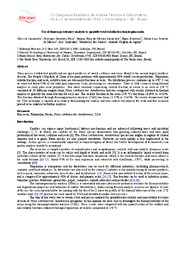Use of thermogravimetry analysis to quantify total volatile fraction in pine resin.
Use of thermogravimetry analysis to quantify total volatile fraction in pine resin.
Author(s): LAZZAROTTO, M.; RUIZ, H. Z.; LAZZAROTTO, S. R. da S.; SCHNITZLER, E.; MORAES, M. L. T. de; CAMBUIM, J.; SANTOS, W. dos; AGUIAR, A. V. de
Summary: Pinus species exhibit fast growth and are good producers of wood, cellulose and resin. Brazil is the second largest producer of resin. The People?s Republic of China is the main producer with approximately 90% world?s resin production. Turpentine, volatile fraction, and rosin, solid fraction, are two major fractions or resin. The distillation process continues up to 170° C can be extracted about 95% of the total gum turpentine resin, preserving its constituents. There is little research using thermal analysis to study pine resin properties. This work involved evaporating volatile fraction of resins in an oven at 170 ºC consisted of 20 different samples from Pinus caribaea var. hondurensis and was compared with results obtained in thermal analysis to quantify the same fraction for each one. The volatile fraction in the oven (170 ºC) was from 14.69% to 24.05%. This fraction obtained through thermogravimetric analysis (TGA) was from 13.37% to 23.64%. The results demonstrate that the TGA technique is capable of accurately determining the volatile and non-volatile fractions of the resin and this technical proved to be suitable for further analyses.
Publication year: 2014
Types of publication: Paper in annals and proceedings
Unit: Embrapa Forestry
Keywords: Breu, Espécie exótica, Pinus Caribaea, Resin, Resina, Terebentina, rosin, turpentine
Observation
Some of Embrapa's publications are published as ePub files. To read them, use or download one of the following free software options to your computer or mobile device. Android: Google Play Books; IOS: iBooks; Windows and Linux: Calibre.
Access other publications
Access the Agricultural Research Database (BDPA) to consult Embrapa's full library collection and records.
Visit Embrapa Bookstore to purchase books and other publications sold by Embrapa.

